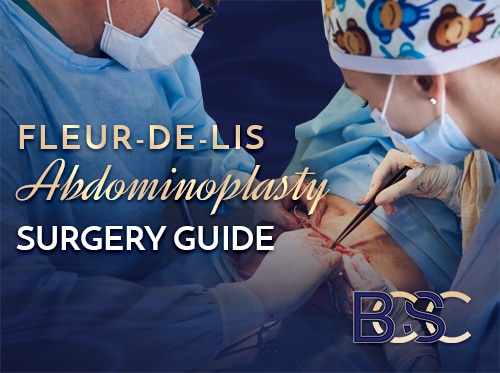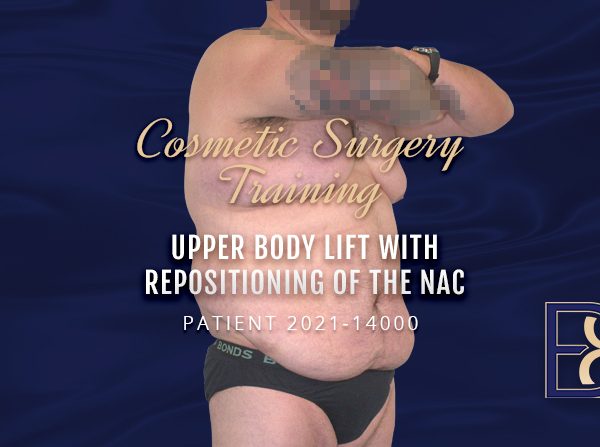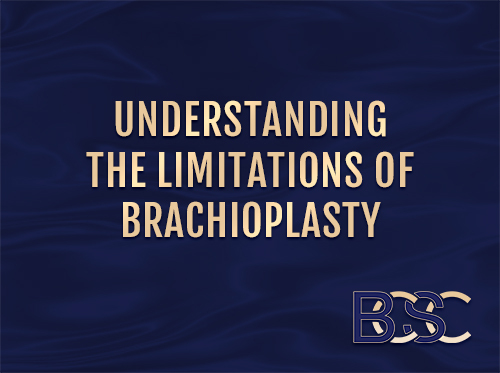Revision Brachioplasty Surgery
If you clicked this article, you probably fall into one of two camps. Either you’ve had a botched arm lift or you’re nervous about your upcoming arm lift surgery and want to plan ahead in case something goes wrong. Regardless of your reason for exploring your brachioplasty revision options, this article will put your mind at ease by explaining how to fix an arm lift gone wrong.
What is arm lift revision surgery?
Arm lift surgery (brachioplasty) removes loose skin and excess fat from the upper arms. It’s most commonly performed after significant weight loss. Every year, thousands of Australians undergo an arm lift procedure in hopes of achieving sleek, toned upper arms. (Ref 1)
Many patients enjoy tighter, smoother arms after removing the excess tissue. However, not everyone has a satisfactory brachioplasty result, even if they followed their surgeon’s aftercare advice and maintained a relatively stable weight after the surgery. A small number of patients undergo a secondary arm lift procedure known as an ‘arm lift revision’ to refine the outcome of their first arm lift surgery.
Revising an arm lift can be as simple as improving the appearance of scars through laser skin resurfacing, or it can be as complex as redoing the entire operation from scratch. It might entail using liposuction to define the arms and remove excess fat. It could involve cutting out the scar and allowing it to heal again. Essentially, the surgical plan can vary greatly depending on the extent of correction needed.
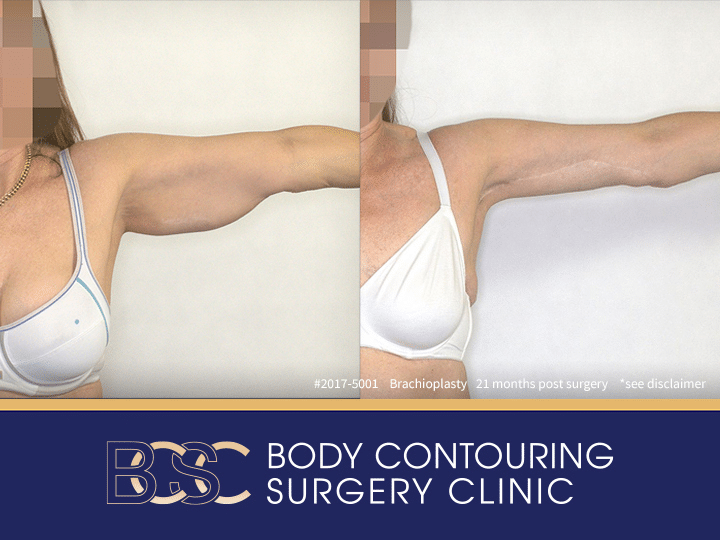
Disclaimer: Operation performed by Dr Bernard Beldholm. Adult content, surgery has risks, individual results vary, seek 2nd opinion. Please see the full disclaimer.
Correcting Unsatisfactory Arm Lift Results
The following issues can be improved with revision arm surgery.
Unfavorable Arm Lift Scarring

Within one to two years, the scars from the surgical procedure typically heal to fine lines. While they may not ever fully disappear, most patients find the arm scars are a worthwhile exchange for removing saggy skin and excess fat. Yet some patients end up with unexpected problems such as keloid scarring, hypertrophic scars, a ‘dog ear’ deformity at the tail end of the scar, or bunching at the incision line.
Options for improving arm lift surgery scars may include:
- Scar tape
- Dermal fillers
- Chemical peels
- Topical scar gel
- Microdermabrasion
- Surgical scar excision
- Laser skin resurfacing
- Applying additional sutures
Contour Irregularities
Body contouring surgery isn’t a perfect science. Occasionally, there can be skin contour abnormalities. For example, dimpling or puckering can occur after overly enthusiastic arm liposuction or unusual scar tissue formation that is beyond the surgeon’s control. If this happens, your surgeon may suggest a minor revision procedure to correct the issue.
Asymmetry
Sometimes, after an upper arm lift procedure, the arms can look asymmetrical. Perhaps there was more excess skin and fat on one arm to begin with. Or the surgeon may have removed more excess skin and fat from one arm compared to the other.
Minor arm asymmetry isn’t usually a serious issue. Perfect symmetry is rare in nature. If you divide your body down the middle, each half is unlikely to be a mirror image of the other side. However, if the asymmetry is obvious after arm lift surgery, a patient may consider going under the knife a second time to remove extra skin and fat from the bigger arm.
Sagging Skin
While your arms may look very tight immediately after the surgery, they won’t necessarily stay that way. The skin often appears excessively firm at first due to temporary swelling from the operation.
Over time, the skin and underlying tissues relax and become softer. Most patients are satisfied with their final results after giving the arms time to heal. Others may find the skin is not as tight as they would like. In these cases, your surgeon may recommend an arm lift revision to tighten the remaining skin.
Here’s a little background on why this issue might occur. During the initial arm lift operation, your surgeon must be careful when deciding how much excess skin and fat to remove. If they remove too much excess tissue, it would be difficult or impossible to close the incision. If they do not remove enough loose skin, the arm lift results can be subpar.
Frankly, it is better for surgeons to be cautious when cutting away the loose skin. Removing significant amounts of tissue can be disastrous, especially if the incision lines won’t close. If that happens, it could require other procedures such as a skin graft, which can leave a significant amount of scarring.
Dr Bernard Beldholm, a specialist general surgeon that regularly performs arm lift operations, puts it this way:
“I make every effort to tighten the skin sufficiently during the first operation so as to avoid other surgeries. Yet it’s important to avoid removing too much tissue, which could cause issues closing the incisions — even if that means the arms may not be as tight as I would like. If necessary, a second procedure can take care of any loose skin that remains.”
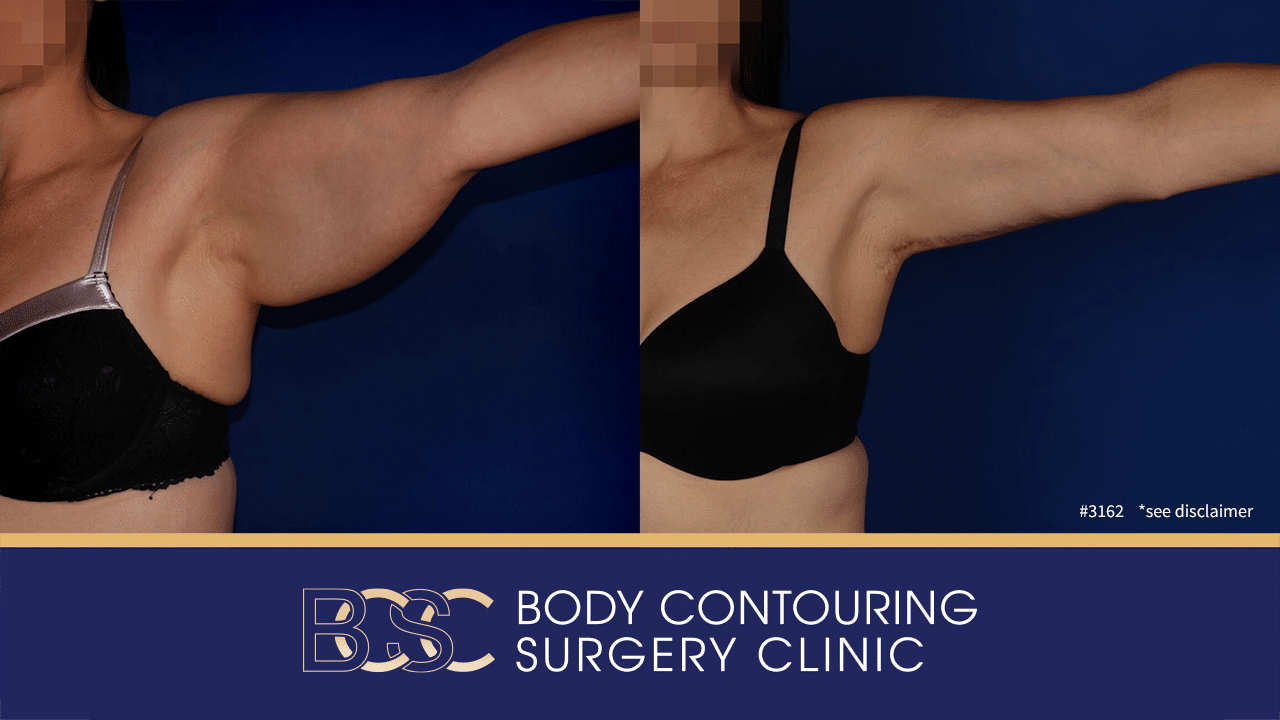
Disclaimer: Operation performed by Dr Bernard Beldholm. Adult content, surgery has risks, individual results vary, seek 2nd opinion. Please see the full disclaimer.
When is the right time to consider an arm lift revision?
If you have unsightly arm lift scars or issues such as asymmetry, your first step is speaking to your surgeon. They can assess whether you’ve had a complication or are simply still healing from your arm lift surgery.
Remember, you won’t see your final results the moment you leave the recovery room. The final arm lift results take time to unfold. Ultimately, the healing process can last one to two years. During that time, the scars usually flatten and fade and the underlying tissues settle into their final position.
If you’ve waited patiently and the issue still hasn’t resolved, it might be time to look into your brachioplasty surgery revision options.

Are there any reasons to avoid a secondary arm lift?
Some arm lift revisions are minor and can be performed in the office. Other revision surgical procedures are more extensive and may therefore require general anaesthesia.
Regardless of the complexity of your case, it’s important to understand that every invasive procedure carries risks. If you opt for a second arm reduction procedure, potential complications might occur. Medical complications can include an infection, excessive bleeding, nerve damage, etc. Skin pigmentation changes are possible, even with laser resurfacing for scars. You’ll need to consider whether you are willing to accept the potential risks of another surgical or invasive procedure before you decide to book an arm lift revision.
Undergoing a secondary arm lift/brachioplasty surgery can also come with a few weeks of downtime. Depending on the extent of the operation, the healing process might take just as long as a traditional arm lift surgery recovery. You’ll need to ask yourself whether you are willing to take time off of work and driving again. You’ll also likely need to wear a compression garment to reduce swelling and allow time for the upper arm lift scars to heal, assuming your surgeon makes new incision lines.
Just like the initial arm lift surgery, your surgeon may tell you to avoid blood thinning medication, smoking, heavy lifting, and NSAIDs for several weeks before and after the procedure. Medications for pain relief may be necessary. For some patients, a second arm lift surgery is more trouble than it’s worth — especially if they only have minor cosmetic concerns.
Finally, it’s crucial to have realistic expectations of what arm revision surgery can do. For example, if the scars from your first surgical procedure have faded reasonably well, there is little benefit to undergoing scar excision therapy.
Is a botched brachioplasty always the surgeon’s fault?

The answer to that question is no, not always. Every patient is unique. Individual differences in healing are often beyond the surgeon’s control. For example, a patient that smokes, has diabetes, eats an unhealthy diet, or has a family history of hypertrophic scars is more likely to have wound healing issues or unsightly scars after body contouring surgery. Likewise, every arm lift patient has a responsibility to follow their surgeon’s aftercare instructions. Failing to do so can cause arm lift complications that may be disfiguring.
Who is most likely to need an arm lift revision?
While anyone that chooses to have arm lift surgery may end up needing a revision, more often than not, it is patients with severe excess skin that find themselves needing revision surgical procedures. The reason? When it comes to treating skin laxity after massive weight loss, it sometimes takes more than one surgery to sufficiently tighten and remove excess skin. Removing skin excess from the upper arm can be notoriously difficult, even for the world’s most acclaimed surgeons. Therefore, it’s wise to choose a highly skilled surgeon that regularly performs arm lifts the first time around.
References
- ISAPS INTERNATIONAL SURVEY ON AESTHETIC/COSMETIC PROCEDURES. Performed in 2020. https://www.isaps.org/media/hprkl132/isaps-global-survey_2020.pdf

